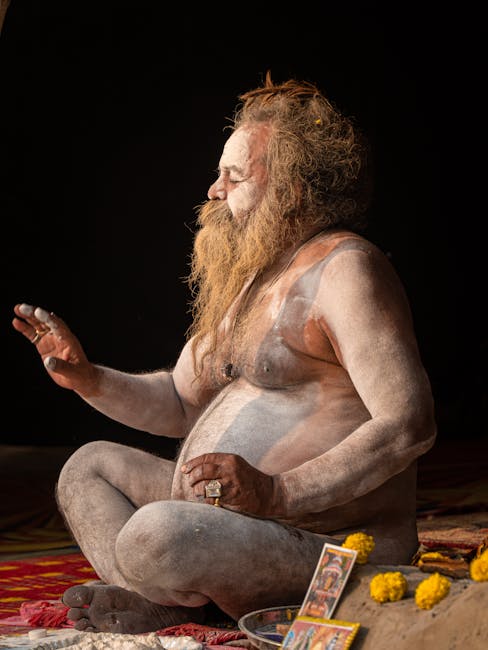The cinematic world is abuzz once more as SS Rajamouli, the visionary director behind global blockbusters like Baahubali and RRR, offered a tantalizing first glimpse into his highly anticipated project starring Superstar Mahesh Babu. Released amidst much fanfare, the first look has set social media ablaze, depicting Mahesh Babu in an unprecedented avatar, wielding a trishul and mounted on a bull against the iconic backdrop of Varanasi. This initial visual not only confirms the film’s grand scale but also hints at a narrative deeply rooted in Indian mythology and culture, characteristic of Rajamouli’s signature storytelling.
The image, which quickly went viral, portrays Mahesh Babu with a raw, intense gaze, dressed in traditional, earthy attire. His stance, holding a formidable trishul – a weapon synonymous with Lord Shiva – while astride a magnificent bull, evokes powerful imagery of ancient protectors or divine beings. The chosen setting of Varanasi, India’s spiritual capital, further amplifies the mythological resonance, suggesting a story that might delve into historical epics or fantasy folklore. This first look serves as a powerful testament to Rajamouli’s commitment to crafting immersive worlds, promising a cinematic experience unlike any seen before from Mahesh Babu.
The Grand Reveal and Its Symbolism
The unveiling was strategically orchestrated, allowing the visual itself to speak volumes without much accompanying text, which only fueled fan speculation and excitement. Mahesh Babu’s transformation is striking; shedding his modern-day romantic hero persona, he embodies a rugged, almost primal warrior. The trishul, a three-pronged spear, is a powerful symbol in Hinduism, representing creation, preservation, and destruction, or the past, present, and future. Its presence in the protagonist’s hand suggests a character with immense power, possibly tasked with maintaining cosmic balance or undertaking a sacred quest.
Similarly, the bull, Nandi, is Shiva’s vahana (mount) and a symbol of strength, virility, and righteousness. Mahesh Babu’s association with these symbols, set against the ancient ghats of Varanasi, famous for their spiritual significance and connection to Shiva, paints a picture of a protagonist intricately linked to divine forces or ancient traditions. This careful curation of imagery indicates Rajamouli’s meticulous attention to detail and his ability to weave rich cultural tapestries into his narratives, resonating deeply with an Indian audience while also possessing universal appeal.
The immediate reaction from fans and industry observers has been overwhelmingly positive, with many praising the boldness of the concept and Mahesh Babu’s willingness to embrace such a radical character shift. “This isn’t just a movie; it’s going to be an experience. Rajamouli has a knack for tapping into the soul of Indian storytelling, and with Mahesh Babu, this project feels destined for greatness,” remarked a prominent film critic on social media, echoing the widespread sentiment.
Varanasi: A Setting Steeped in Mythology
The choice of Varanasi as the backdrop for this pivotal first look is no mere coincidence. Known as Kashi, the city is one of the oldest continually inhabited cities in the world and is considered among the holiest sites in Hinduism. Situated on the banks of the sacred River Ganga, Varanasi is believed to be the abode of Lord Shiva. Its narrow alleys, ancient temples, and bustling ghats, where life and death intertwine daily, offer an unparalleled spiritual and visual canvas. Rajamouli’s decision to feature this iconic city suggests that its spiritual energy and historical depth will likely play a significant role in the film’s narrative. It could serve as a focal point for the story, a source of ancient power, or a battleground for forces of good and evil.
The visual of Mahesh Babu on a bull, specifically, could be an allusion to Rudra, an ancient Vedic deity associated with storms, wind, and the hunt, who later evolved into Shiva. This deep dive into older mythologies or perhaps an alternate interpretation of existing legends would be characteristic of Rajamouli, who often grounds his fantastical elements in believable historical or mythical contexts. The film, currently referred to as SSMB29, is anticipated to be a globe-trotting adventure, but this first glimpse firmly establishes its roots in the heartland of India’s spiritual heritage.
The collaboration between Rajamouli and Mahesh Babu has been one of the most anticipated pairings in Indian cinema for years. Rajamouli’s track record of crafting epic tales that transcend linguistic barriers, coupled with Mahesh Babu’s charismatic screen presence and massive pan-India appeal, creates an unprecedented level of expectation. The first look has not only confirmed the potential grandeur of the project but also ignited a fervent discussion about its possible themes, genre, and storytelling direction. As details slowly emerge, one thing is certain: the world is ready to witness the next epic chapter from the maestro storyteller and his new cinematic muse.
The journey of SSMB29 has just begun with this powerful first impression, promising a film that will likely push the boundaries of Indian cinema, delivering a narrative rich in cultural context, breathtaking visuals, and a compelling performance from Mahesh Babu.




